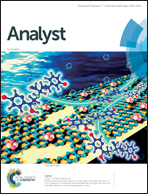Transformations to reduce the effect of particle size in mid-infrared spectra of biomass
Abstract
Fourier Transform InfraRed (FTIR) spectroscopy is a very powerful technique for the characterization of the chemical composition of biomass and its modifications occurring during thermochemical and chemical pretreatments. However, method development is necessary to generate reproducible signals that can be used in combination with multivariate techniques (such as principal component analysis, PCA) to extract meaningful information on biomass composition and bond cleavage. Particle size is a great source of spectra variability in FTIR of biomass. The FTIR signal for an array of particle sizes (2–0.075 mm) was evaluated for hardwood and switchgrass, revealing that 0.5 mm renders higher intensity and spectral reproducibility for both the FTIR sampling techniques investigated (ATR and HTS-XT). Furthermore, the suitability of different signal processing approaches to decrease particle size variability of spectral signals was tested (signal normalization, derivation, and their combination). Normalization showed the highest contribution to enhance ATR spectral reproducibility of both biomass, as statistically shown by the 5-fold decrease of the ratio of signal variance with magnitude of spectral features (VM ratio) with respect to the unprocessed signal. Spectral signal analysis in combination with multivariate statistics (PCA) was used to extract information about the chemical differences between hardwood and switchgrass. The agreement of the biomass composition findings from FTIR-PCA and literature wet chemistry results (acid hydrolysis) contributed to corroborating that FTIR combined with PCA is a clean, quick, efficient, and versatile technique with potential to analyze and characterize biomass composition.



 Please wait while we load your content...
Please wait while we load your content...